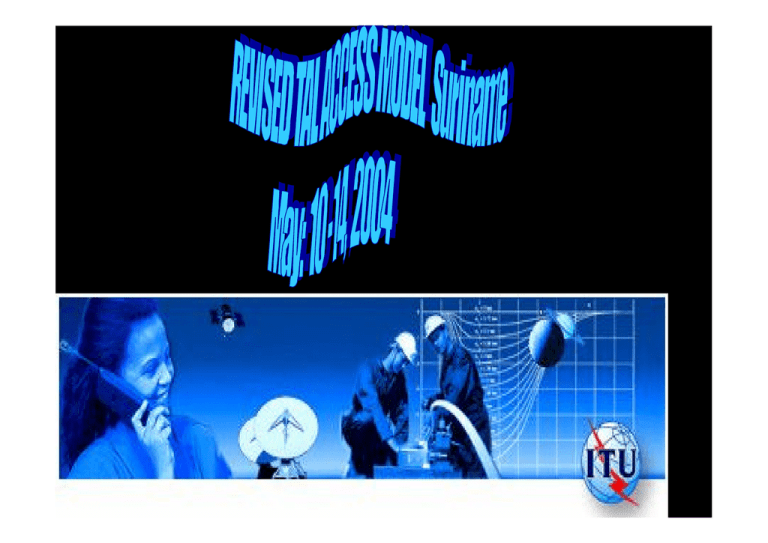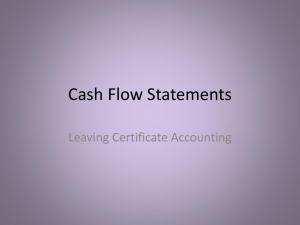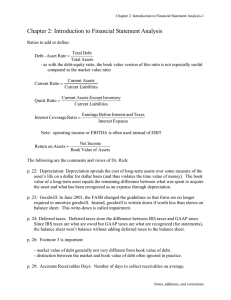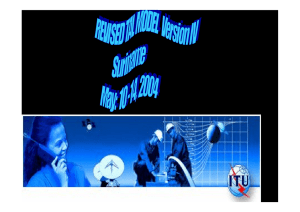1
advertisement

1 Concept of Access • To the average subscriber in TAL countries access entails more than availability of telephone line. Access should be extended to include local and trunk voice telephony services • 2 Revision, TAL Access Cost Model Model amended to estimate: • Unit costs of dedicated subscriber line. • Per minute costs basic voice telephony services (of local and trunk). • Access deficit on basic services. 3 Basic Access Network 4 National Network 5 Possible Cost Model Architecture for (PSTN) Fixed Network Sources of Data Extract following data from the Plant Accounts Determine network cost of services (4) (5) (6) Technology Cost Pool Cost Driver Services Element / Functionality Local Loop Underground Conduit Cable Poles etc. Determine weighted average cost of capital Apply cost drivers and routing factors (3) Annualized Capital Cost Switch Group Elements into Cost Pools Loop distance # lines in service Line miles in service sensitive costs Line termination Signalling Signalling and Setup & Setup/ Minutes of Use No. of call attempts Routing Factors Identify network support costs from general ledger Unbundle Technology Groups to Technology Elements (2) Engineering Studies • (1) • Opening & Closing Net Book Values • Depreciation Charge for the period • Date of Commissioning of Assets Determine capital works in progress by asset class Reclassify to Technology Groups Classify plant account records into following technology groups and determine annualized capital cost Services Trunk Termination Minutes of Use Conveyance Transmission Electronics Satellite Equipment Direct Microwave Equipment Fibre Optic Equipment 6 Local Loop Inventory • Access Network Inventory Component 1.Average Cable Length (km) (i) Distribution (ii) Feeder 2. Average Trench length (km) (i) Without adjustment for sharing (ii) With adjustment for sharing 3. Number of pillars Line Cards Non-traffic sensitive parts of switch Proportion of shared site Additional Equipment for rural and Remote-rural customers Total Urban Sub Urban Rural Remote Rural 7 Local Loop Inventory Cable Distribution Urban Sub Urban Rural Total Average Cable Length q Distribution (km) q Feeder (km) Trench Length (km) Trench Sharing factor Total Trench length (km) Number of pillars 8 Annualizing Costs Access Network Component Costs (Investment) Annualized Component Purchase % Change in % Exchange Life of Rate Price of Asset. Price of Asset Variation Asset Adjusted Depreciation Costs Copper Cable Trench Line Cards Non-traffic sensitive parts of switch Additional Equipment for rural and remote rural customers Total Investment Cost 9 Depreciation Formula ßk = ?k [(1+ ? p - ? e)] Where: • ßk = Adjustment to current cost • ?k = Depreciation allowance • ? p = % change in price of asset between year of installation and year n • ? e = % change in value of currency between year of asset purchase and year n. 10 • This formula should give similar results as that detailed in COSITU: • • (ii) ACC = AMO [(1+ t )D/2 /(1- e)D/2 – 1] • • Where: • ACC = adjustment to current cost • AMO = amortization allowance • t = annual average growth rate in price of equipment • D/2 = depreciation period divided by 2 • e = average annual rate in currency depreciation 11 Current Cost Adjustment Effect of Exchange rate adjustment on cost may be estimated by: CAD = DA[(1+ τ)DP/2 /(1-ε)DP/2 –1] Where: CAD = Adjustment to current cost; DA = Depreciation allowance; τ = Average annual variation in equipment price; • 12 DP = Depreciation period; ε = Average per annum rate in currency movement. 13 Cost of Capital Combined effect of debt and equity (i) Creditors demand interest (ii) Owners demand dividends Firms normally raise capital through: q Long term & short term debt q Sale of Preferred stock q Sale of common stock q Retained earnings These cost are basic determinants of the cost of capital. 14 Cost of Debt Cost of debt is determined by: • Interest rate on debt; subject to: • Adjustment for taxes where interest payment on debt are deductible for income tax purposes. • After tax cost of debt can be expressed as: (interest rate) * (1- tax rate) • E.g. If interest rate is 9% and tax rare of 25% • The after tax cost of debt = (0.09)*(1- 0.25) = 0.0675 15 Marginal Cost of Debt Cost of debt should be calculated at marginal cost: • Current interest rates on the market • Taking into account interest rates on similar enterprise on the international market 16 Cost of Equity • Required rate of return (s ) on the common stock of the firm • Firms use Expected rate of return. • The Expected Rate of return on a stock is a risky variable. • s = risk-free rate of return σ(RF) + Risk Premium (RP). • RF is normally reflective of interest on government security. • RP is the difference between the required rate & risk free rate of return 17 • • • RF = ƒ(rate on government securities ) RP = ƒ(different methodology of estimation) Interest on firms long term bonds (iC ) + a percentage-points addition based on historical returns per year on the financial market (iA). Let RF,iC & iA be 6%, 9% and 5% respectively: • iC + iA = (0.09 + 0.05) = 0.14 • RP = 0.14 – 0.06 = 0.08 • s = 0.14 18 Jeorgenson Method qThe cost of capital d is calculated using the formula: formula • d = D i* (i-t) + E s D+E D+E Where: D = amount of medium and long term debt; σ = before tax return on capital; E = equity; and i = average interest rate. t = rate of corporation tax. 19 Estimating Demand • iii). D a = Ln + Ln* • Where: • Ln = Number of existing lines as indicated at Table IV • Ln*= unfulfilled request for line installation • • Potential demand Dp is given as: • • (iv). Dp = Daa 20 • Where: • a = a factor for long run growth in demand for lines. Therefore total demand for lines (Dt) is: • • (v). Dt = Da (1+a) 21 Estimating Unit Cost • Long Run Average Total Cost (LRATC) per line is the ratio: total cost/total demand for lines: • • (v). LRATC = ATC/ Dt 22 Efficiency Adjustment • LRATC = ATC (1-ß) • Dt • Where ß is the adjustment factor for excess capacity. Since the situation in most countries of the Americas is excess demand for subscriber lines, the efficiency factor in COSITU is sufficient 23 Local/urban Tariff • Local/Urban: tariff levied by operators on end users for traffic carried between consumers who are located in the same local charging area and where such traffic is carried end-to-end on the network of the operator imposing the charge for the service 24 Long Distance Tariff • Trunk/Inter Urban: tariff levied by operators on end users for traffic carried between consumers who are located in different local charging areas and where such traffic is carried end-to-end on the network of the operator imposing the charge for the service. • 25 Zone 1 Telephone "B" Telephone "D" Telephone "A" Zone 2 Telephone "C" 26 Stages of cost-orientated Unit Costs •Cost of of network components components •Operation and maintenance costs costs •Service traffic •Amortization rules •Equipment price trends •Cost of capital •Cost of functional support •Identifiable direct and indirect costs costs •Other common costs •Routing table •Cost distribution distribution COSITU - The ITU tariff model •Unit endogenous cost of services 23 27 Two Basic Costing Principles • Causality: – The demonstration of a clear cause-and-effect relationship between service delivery, on the one hand, and the network elements and other resources used to provide it, on the other hand, taking account of relevant cost determinants (cost inducers/drivers). • Efficiency: – The provision of a forecast of cost reductions that result from a more efficient combination of resources. 28 The Economics of LRAEC LRAEC MARGINAL COST EFFICIENT COST 29 Parent Formula • • • • • • • • • General LREC formula: C = A(ß)/Mo Where: C= per minute cost of traffic A= total cost (direct, indirect and common) ß = Efficiency factor = x/y x = required capacity y = installed capacity 30 Mo = traffic throughput. throughput Cost Adjustment? • Historical costs: Based on the cost price of equipment and services, • Current costs: Take account of the changing environment: falling prices of telecommunication equipment, currency depreciation. The TAL Model utilizes current costs as confirmed on the relevant market. 31 Clarity re consistency with Fundamental Costing Principles • • • • Parent TAL formula: C = A(ß)/Mo LEC = (A/Mo ) *(∑∝) The efficiency factor ∝, is estimated in terms of adjustment in OPEX and or adjustment for avoidable excess network capacity. 32 Operating and maintenance costs q Cost of inputs ü Purchases and variations in stock ; ü Transport; ü Outside services q Personnel costs q Taxes and levies (corporation Tax not included q Other charges q Other Financial and similar charges q Operating provisions 33 Network Efficiency (Ne) • Ne = tc + tc+1 -? = 0 Where: Ø tc is Current traffic; Ø ti is Expected traffic where i = 1 to n; Ø ? is Network capacity. capacity • 34 Evaluating Total Efficiency Factor • Same as TAL Parent & Interconnect Models. 35 Avoidable/Unavoidable Excess Capacity Same Principles as TAL model are applicable. 36 Unit Cost of Local/Urban traffic Amj = TC j x ϖj • TDmj Where: • Amj = LEC unit cost of local/urban traffic; • TCj = % of total cost of local and remote switching dedicated to local traffic; • TDmj = Total minutes of local/urban traffic over local and remote switches; and • ϖj = Network efficiency factor. • 37 Unit Cost of Trunk Traffic Amt = TCt x ϖj TDmt Where: Amt = LEC unit cost of trunk/interurban traffic; TCt = % of total cost of local, remote and tandem switching plus transmission facilities dedicated to trunk/interurban traffic; TDmt = Total minutes of trunk/interurban traffic; = Network efficiency factor. ϖj 38 COSITU REVISION • Both formulae are to be included in COSITU. 39 Estimating Local Loop Deficit • • • • • • (ATC/ Dt) - (? NS * Cc + Msf * NS * 12) Where: Cc = connection charge Msf = monthly subscription NS = number of subscribers ? NS= growth in the number of subscribers 40 Estimating Access Deficit on Urban traffic • (x). Amj = TCj x ϖj - PL • TDmj • • Where: • PL = price per minute of a local call. • 41 Estimating Deficit on Trunk Tariff Amj = TCj x ϖj - PL • TDmj Where: • PL = price per minute of a local call. 42 43






